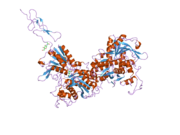메타보틱성 글루탐산염 수용체 3
Metabotropic glutamate receptor 3| GRM3 | |||||||||||||||||||||||||
|---|---|---|---|---|---|---|---|---|---|---|---|---|---|---|---|---|---|---|---|---|---|---|---|---|---|
 | |||||||||||||||||||||||||
| |||||||||||||||||||||||||
| 식별자 | |||||||||||||||||||||||||
| 별칭 | GRM3, GLUR3, GPRC1C, MGLUR3, mGlu3, 글루타민 메타보틱스 수용체 3 | ||||||||||||||||||||||||
| 외부 ID | OMIM: 601115 MGI: 1351340 호몰로진: 651 GeneCard: GRM3 | ||||||||||||||||||||||||
| |||||||||||||||||||||||||
| |||||||||||||||||||||||||
| |||||||||||||||||||||||||
| 직교체 | |||||||||||||||||||||||||
| 종 | 인간 | 마우스 | |||||||||||||||||||||||
| 엔트레스 | |||||||||||||||||||||||||
| 앙상블 | |||||||||||||||||||||||||
| 유니프로트 | |||||||||||||||||||||||||
| RefSeq(mRNA) | |||||||||||||||||||||||||
| RefSeq(단백질) | |||||||||||||||||||||||||
| 위치(UCSC) | Chr 7: 86.64 – 86.86Mb | n/a | |||||||||||||||||||||||
| PubMed 검색 | [2] | [3] | |||||||||||||||||||||||
| 위키다타 | |||||||||||||||||||||||||
| |||||||||||||||||||||||||
메타보틱성 글루탐산염 수용체 3(mGluR3)은 고전 회로 내 뉴런의 사전 시냅스 부위에 일반적으로 국부화된 Gi/G결합0 G-단백 결합 수용체(GPCR)[4]이다.[5]그러나 영장류에서 피질 회로가 더 높은 경우 mGluR3는 시냅스 연결을 약화시키기보다는 강화시키는 시냅스 후 국부화된다.[6]인간에서 mGluR3는 GRM3 유전자에 의해 암호화된다.[7][8]mGluR3 신호의 부족은 인간의 인지능력 저하 [9]및 정신분열증 위험 증가와 연관되어 있으며,[10] 이는 피질 진화에서 그들의 역할 확대와 일치한다.
구조
인간에서 mGluR3는 7번 염색체의 GRM3 유전자에 의해 암호화된다.유전자 정보를 바탕으로 최소 5개의 단백질 부호화 이소폼이 예측된다.mGluR3 단백질은 7-pass transmbrane 단백질이다.
함수
L-글루탐산염은 중추신경계의 주요 흥분 신경전달물질로 이온성 및 메타보틱성 글루탐산염 수용체를 모두 활성화한다.글루타마테리아성 신경전달은 정상적인 뇌 기능의 대부분의 측면에 관여하며 많은 신경병리학적 조건에서 동요될 수 있다.메타보틱성 글루탐산염 수용체는 G 단백질 결합 수용체 계열로, 시퀀스 호몰로지, 퍼팅 신호 전달 메커니즘, 약리학적 특성에 기초해 3개 그룹으로 나뉜다.그룹 I는 GRM1과 GRM5를 포함하며 이러한 수용체들은 인광산화효소 C를 활성화하는 것으로 나타났다.그룹 II는 GRM2와 GRM3를 포함하고 그룹 III는 GRM4, GRM6, GRM7 및 GRM8을 포함한다. 그룹 II와 III 수용체는 주기적 AMP 계단식 억제와 연계되어 있으나 작용제 선택성은 다르다.[8]
임상적 유의성
GRM3 유전자가 인코딩한 mGluR3 수용체는 조현병뿐 아니라 조울증 정서장애[11] 등 다양한 정신질환과 관련이 있는 것으로 밝혀졌다.[12][10]
GRM3 유전자의 1 exon에서 코작 염기서열의 돌연변이는 복제된 GRM3 유전자 구성물의 번역과 전사를 변화시키는 것으로 나타났으며, 승산비가 4.4인 조울증 장애와 유의하게 관련되었다.[11]그 후 GRM3의 한 마커는 통계적으로−9 유의미한 조현병 관련 대규모 게놈전역 연관 연구에 포함되었다.[13]코작 염기서열 변종에 대한 후속 연구는 그것이 조울증, 정신분열증, 알코올 중독의 위험 증가와 관련이 있다는 것을 보여주었다.[14]GRM3가 인코딩한 mGluR3 수용체는 이전 조현병·불안장애 임상시험에서 사용한 여러 약물이 표적이 된다.mGluR3의 작용제, 길항제, 알로스테리 모듈레이터 약물은 이제 정신질환의 새로운 치료법으로 탐구될 수 있다.[11]잘 확립된 항만성 약물인 리튬 탄산염도 탄산리튬으로 치료한 후 생쥐 뇌에서 GRM3 유전자 발현을 변화시킨다는 것을 보여주는 다른 과학적 증거가 발표되었다.[15]
리간즈
isoform mGluR2에 비해 상당히 선택적인 mGluR3 변조기는 2013년부터 알려져 있다.
고민자
- 자전거[3.1.0]타원형의 골격으로
- (R)-2-아미노-4-(4-하이드록시[1,2,5]티아졸-3-yl)부티르산[22]
반목자
- CECXG – mGlu를2 통한 mGlu에3 대한 38배 선택성
- LY-341,495 및 1-불화탄성 아날로그:[23] 강력한 정형외과적 길항제
- MGS-0039,[24] HIDIA[25](자전거[3.1.0]헥산 골격 둘 다 포함)
알로스테릭 변조기
- D-ML3373: 선택적 NAM, IC50 = mGluR3의 경우 450nM, mGluR2의[26] 경우 IC50 >30μM
- MNI-137:[27] 억제제
- VU-0650786: NAM[28]
- 복합 7p:[29] 비응축적 길항제(확장성 알로스테릭 억제제)
상호작용
메타보틱스 글루탐산염 수용체 3은 다음과 상호작용하는 것으로 나타났다.
참고 항목
참조
- ^ a b c GRCh38: 앙상블 릴리스 89: ENSG00000198822 - 앙상블, 2017년 5월
- ^ "Human PubMed Reference:". National Center for Biotechnology Information, U.S. National Library of Medicine.
- ^ "Mouse PubMed Reference:". National Center for Biotechnology Information, U.S. National Library of Medicine.
- ^ Ambrosini A, Bresciani L, Fracchia S, Brunello N, Racagni G (May 1995). "Metabotropic glutamate receptors negatively coupled to adenylate cyclase inhibit N-methyl-D-aspartate receptor activity and prevent neurotoxicity in mesencephalic neurons in vitro" (abstract). Molecular Pharmacology. 47 (5): 1057–64. PMID 7746273.
- ^ Shigemoto R, Kinoshita A, Wada E, Nomura S, Ohishi H, Takada M, et al. (October 1997). "Differential presynaptic localization of metabotropic glutamate receptor subtypes in the rat hippocampus". The Journal of Neuroscience. 17 (19): 7503–22. doi:10.1523/JNEUROSCI.17-19-07503.1997. PMC 6573434. PMID 9295396.
- ^ Jin LE, Wang M, Galvin VC, Lightbourne TC, Conn PJ, Arnsten AF, Paspalas CD (March 2018). "mGluR2 versus mGluR3 Metabotropic Glutamate Receptors in Primate Dorsolateral Prefrontal Cortex: Postsynaptic mGluR3 Strengthen Working Memory Networks". Cerebral Cortex. 28 (3): 974–987. doi:10.1093/cercor/bhx005. PMC 5974790. PMID 28108498.
- ^ Scherer SW, Duvoisin RM, Kuhn R, Heng HH, Belloni E, Tsui LC (January 1996). "Localization of two metabotropic glutamate receptor genes, GRM3 and GRM8, to human chromosome 7q". Genomics. 31 (2): 230–3. doi:10.1006/geno.1996.0036. PMID 8824806.
- ^ a b "Entrez Gene: GRM3 glutamate receptor, metabotropic 3".
- ^ Zink CF, Barker PB, Sawa A, Weinberger DR, Wang M, Quillian H, Ulrich WS, Chen Q, Jaffe AE, Kleinman JE, Hyde TM, Prettyman GE, Giegerich M, Carta K, van Ginkel M, Bigos KL (December 2020). "Association of Missense Mutation in FOLH1 With Decreased NAAG Levels and Impaired Working Memory Circuitry and Cognition". The American Journal of Psychiatry. 177 (12): 1129–1139. doi:10.1176/appi.ajp.2020.19111152. PMID 33256444. S2CID 227243375.
- ^ a b Saini SM, Mancuso SG, Mostaid MS, Liu C, Pantelis C, Everall IP, Bousman CA (August 2017). "Meta-analysis supports GWAS-implicated link between GRM3 and schizophrenia risk". Translational Psychiatry. 7 (8): e1196. doi:10.1038/tp.2017.172. PMC 5611739. PMID 28786982.
- ^ a b c Kandaswamy R, McQuillin A, Sharp SI, Fiorentino A, Anjorin A, Blizard RA, et al. (June 2013). "Genetic association, mutation screening, and functional analysis of a Kozak sequence variant in the metabotropic glutamate receptor 3 gene in bipolar disorder". JAMA Psychiatry. 70 (6): 591–8. doi:10.1001/jamapsychiatry.2013.38. PMID 23575746.
- ^ Fromer M, Pocklington AJ, Kavanagh DH, Williams HJ, Dwyer S, Gormley P, et al. (February 2014). "De novo mutations in schizophrenia implicate synaptic networks". Nature. 506 (7487): 179–84. Bibcode:2014Natur.506..179F. doi:10.1038/nature12929. PMC 4237002. PMID 24463507.
- ^ Ripke S, Neale BM, Corvin A, Walters JT, Farh KH, Holmans PA, et al. (Schizophrenia Working Group of the Psychiatric Genomics Consortium) (July 2014). "Biological insights from 108 schizophrenia-associated genetic loci". Nature. 511 (7510): 421–7. Bibcode:2014Natur.511..421S. doi:10.1038/nature13595. PMC 4112379. PMID 25056061.
- ^ O'Brien NL, Way MJ, Kandaswamy R, Fiorentino A, Sharp SI, Quadri G, et al. (December 2014). "The functional GRM3 Kozak sequence variant rs148754219 affects the risk of schizophrenia and alcohol dependence as well as bipolar disorder". Psychiatric Genetics. 24 (6): 277–8. doi:10.1097/YPG.0000000000000050. PMC 4272221. PMID 25046171.
- ^ McQuillin A, Rizig M, Gurling HM (August 2007). "A microarray gene expression study of the molecular pharmacology of lithium carbonate on mouse brain mRNA to understand the neurobiology of mood stabilization and treatment of bipolar affective disorder". Pharmacogenetics and Genomics. 17 (8): 605–17. doi:10.1097/FPC.0b013e328011b5b2. PMID 17622937. S2CID 31180768.
- ^ Nakazato A, Kumagai T, Sakagami K, Yoshikawa R, Suzuki Y, Chaki S, et al. (December 2000). "Synthesis, SARs, and pharmacological characterization of 2-amino-3 or 6-fluorobicyclo[3.1.0]hexane-2,6-dicarboxylic acid derivatives as potent, selective, and orally active group II metabotropic glutamate receptor agonists". Journal of Medicinal Chemistry. 43 (25): 4893–909. doi:10.1021/jm000346k. PMID 11123999.
- ^ Monn JA, Massey SM, Valli MJ, Henry SS, Stephenson GA, Bures M, et al. (January 2007). "Synthesis and metabotropic glutamate receptor activity of S-oxidized variants of (-)-4-amino-2-thiabicyclo-[3.1.0]hexane-4,6-dicarboxylate: identification of potent, selective, and orally bioavailable agonists for mGlu2/3 receptors". Journal of Medicinal Chemistry. 50 (2): 233–40. doi:10.1021/jm060917u. PMID 17228865.
- ^ Monn JA, Valli MJ, Massey SM, Hansen MM, Kress TJ, Wepsiec JP, et al. (March 1999). "Synthesis, pharmacological characterization, and molecular modeling of heterobicyclic amino acids related to (+)-2-aminobicyclo[3.1.0] hexane-2,6-dicarboxylic acid (LY354740): identification of two new potent, selective, and systemically active agonists for group II metabotropic glutamate receptors". Journal of Medicinal Chemistry. 42 (6): 1027–40. doi:10.1021/jm980616n. PMID 10090786.
- ^ Monn JA, Valli MJ, Massey SM, Wright RA, Salhoff CR, Johnson BG, et al. (February 1997). "Design, synthesis, and pharmacological characterization of (+)-2-aminobicyclo[3.1.0]hexane-2,6-dicarboxylic acid (LY354740): a potent, selective, and orally active group 2 metabotropic glutamate receptor agonist possessing anticonvulsant and anxiolytic properties". Journal of Medicinal Chemistry. 40 (4): 528–37. doi:10.1021/jm9606756. PMID 9046344.
- ^ Dominguez C, Prieto L, Valli MJ, Massey SM, Bures M, Wright RA, et al. (May 2005). "Methyl substitution of 2-aminobicyclo[3.1.0]hexane 2,6-dicarboxylate (LY354740) determines functional activity at metabotropic glutamate receptors: identification of a subtype selective mGlu2 receptor agonist". Journal of Medicinal Chemistry. 48 (10): 3605–12. doi:10.1021/jm040222y. PMID 15887967.
- ^ Monn JA, Henry SS, Massey SM, Clawson DK, Chen Q, Diseroad BA, et al. (March 2018). "Synthesis and Pharmacological Characterization of C4β-Amide-Substituted 2-Aminobicyclo[3.1.0]hexane-2,6-dicarboxylates. Identification of (1 S,2 S,4 S,5 R,6 S)-2-Amino-4-[(3-methoxybenzoyl)amino]bicyclo[3.1.0]hexane-2,6-dicarboxylic Acid (LY2794193), a Highly Potent and Selective mGlu3 Receptor Agonist". Journal of Medicinal Chemistry. 61 (6): 2303–2328. doi:10.1021/acs.jmedchem.7b01481. PMID 29350927.
- ^ Clausen RP, Bräuner-Osborne H, Greenwood JR, Hermit MB, Stensbøl TB, Nielsen B, Krogsgaard-Larsen P (September 2002). "Selective agonists at group II metabotropic glutamate receptors: synthesis, stereochemistry, and molecular pharmacology of (S)- and (R)-2-amino-4-(4-hydroxy[1,2,5]thiadiazol-3-yl)butyric acid". Journal of Medicinal Chemistry. 45 (19): 4240–5. doi:10.1021/jm020122x. PMID 12213064.
- ^ Sakagami K, Yasuhara A, Chaki S, Yoshikawa R, Kawakita Y, Saito A, et al. (April 2008). "Synthesis, in vitro pharmacology, and pharmacokinetic profiles of 2-[1-amino-1-carboxy-2-(9H-xanthen-9-yl)-ethyl]-1-fluorocyclopropanecarboxylic acid and its 6-heptyl ester, a potent mGluR2 antagonist". Bioorganic & Medicinal Chemistry. 16 (8): 4359–66. doi:10.1016/j.bmc.2008.02.066. PMID 18348906.
- ^ A)Nakazato A, Sakagami K, Yasuhara A, Ohta H, 요시카와 R, Itoh M,(알.(2004년 8월)."강지 진동 합성, 시험관 내 약학, structure-activity 관계, 그리고 3-alkoxy-2-amino-6-fluorobicyclo[3.1.0]hexane-2,6-dicarboxylic 산성 파생 상품의 약물 동력학에와 선택적 강력한 그룹 IImetabotropic 글루탐산 수용체 길항제".필기장 소독 내 화학의.(18):4570–87. doi:10.1021/jm0400294.PMID 15317467.,
B)Yasuhara A, 나카무라 M, Sakagami K, 시마자키 T, 요시카와 R, Chaki S,(알.(2006년 6월)."3의 Prodrugs(3,4-dichlorobenzyloxy)-2-amino-6-fluorobicyclo[3.1.0]hexane-2,6-dicarboxylic 산성(MGS0039):어 잠재되고 구두로 적극적인 그룹 IIantidepressant-like 잠재력을 보유한 적수 mGluR".Bioorganic &, 약용 화학. 14(12):4193–207. doi:10.1016/j.bmc.2006.01.060.PMID 16487713.,
c) Yasuhara A, Sakagami K, Yoshikawa R, Chaki S, Nakamura M, Nakazato A (May 2006). "Synthesis, in vitro pharmacology, and structure-activity relationships of 2-aminobicyclo[3.1.0]hexane-2,6-dicarboxylic acid derivatives as mGluR2 antagonists". Bioorganic & Medicinal Chemistry. 14 (10): 3405–20. doi:10.1016/j.bmc.2005.12.061. PMID 16431115. - ^ Woltering TJ, Adam G, Huguenin P, Wichmann J, Kolczewski S, Gatti S, et al. (February 2008). "Asymmetric synthesis and receptor pharmacology of the group II mGlu receptor ligand (1S,2R,3R,5R,6S)-2-amino-3-hydroxy-bicyclo[3.1.0]hexane-2,6-dicarboxylic acid-HYDIA". ChemMedChem. 3 (2): 323–35. doi:10.1002/cmdc.200700226. PMID 18058780. S2CID 1695024.
- ^ Wenthur CJ, Morrison R, Felts AS, Smith KA, Engers JL, Byers FW, et al. (June 2013). "Discovery of (R)-(2-fluoro-4-((-4-methoxyphenyl)ethynyl)phenyl) (3-hydroxypiperidin-1-yl)methanone (ML337), an mGlu3 selective and CNS penetrant negative allosteric modulator (NAM)". Journal of Medicinal Chemistry. 56 (12): 5208–12. doi:10.1021/jm400439t. PMC 3769689. PMID 23718281.
- ^ Hemstapat K, Da Costa H, Nong Y, Brady AE, Luo Q, Niswender CM, et al. (July 2007). "A novel family of potent negative allosteric modulators of group II metabotropic glutamate receptors". The Journal of Pharmacology and Experimental Therapeutics. 322 (1): 254–64. doi:10.1124/jpet.106.117093. PMID 17416742. S2CID 3820477.
- ^ Engers JL, Bollinger KA, Weiner RL, Rodriguez AL, Long MF, Breiner MM, et al. (September 2017). "Design and Synthesis of N-Aryl Phenoxyethoxy Pyridinones as Highly Selective and CNS Penetrant mGlu3 NAMs". ACS Medicinal Chemistry Letters. 8 (9): 925–930. doi:10.1021/acsmedchemlett.7b00249. PMC 5601378. PMID 28947938.
- ^ Woltering TJ, Wichmann J, Goetschi E, Adam G, Kew JN, Knoflach F, et al. (April 2008). "Synthesis and characterization of 1,3-dihydro-benzo[b][1,4]diazepin-2-one derivatives: Part 3. New potent non-competitive metabotropic glutamate receptor 2/3 antagonists". Bioorganic & Medicinal Chemistry Letters. 18 (8): 2725–9. doi:10.1016/j.bmcl.2008.02.076. PMID 18374569.
- ^ a b Hirbec H, Perestenko O, Nishimune A, Meyer G, Nakanishi S, Henley JM, Dev KK (May 2002). "The PDZ proteins PICK1, GRIP, and syntenin bind multiple glutamate receptor subtypes. Analysis of PDZ binding motifs". The Journal of Biological Chemistry. 277 (18): 15221–4. doi:10.1074/jbc.C200112200. PMID 11891216.
- ^ Flajolet M, Rakhilin S, Wang H, Starkova N, Nuangchamnong N, Nairn AC, Greengard P (December 2003). "Protein phosphatase 2C binds selectively to and dephosphorylates metabotropic glutamate receptor 3". Proceedings of the National Academy of Sciences of the United States of America. 100 (26): 16006–11. Bibcode:2003PNAS..10016006F. doi:10.1073/pnas.2136600100. PMC 307683. PMID 14663150.
추가 읽기
- Makoff A, Volpe F, Lelchuk R, Harrington K, Emson P (August 1996). "Molecular characterization and localization of human metabotropic glutamate receptor type 3". Brain Research. Molecular Brain Research. 40 (1): 55–63. doi:10.1016/0169-328X(96)00037-X. PMID 8840013.
- Emile L, Mercken L, Apiou F, Pradier L, Bock MD, Menager J, et al. (May 1996). "Molecular cloning, functional expression, pharmacological characterization and chromosomal localization of the human metabotropic glutamate receptor type 3". Neuropharmacology. 35 (5): 523–30. doi:10.1016/0028-3908(96)84622-3. PMID 8887960. S2CID 12697831.
- Corti C, Sala CF, Yang F, Corsi M, Xuereb JH, Ferraguti F (December 2000). "Genomic organization of the human metabotropic glutamate receptor subtype 3". Journal of Neurogenetics. 14 (4): 207–25, 271. doi:10.3109/01677060009084499. PMID 11342382. S2CID 44398182.
- Corti C, Xuereb JH, Corsi M, Ferraguti F (August 2001). "Identification and characterization of the promoter region of the GRM3 gene". Biochemical and Biophysical Research Communications. 286 (2): 381–7. doi:10.1006/bbrc.2001.5391. PMID 11500049.
- Tomiyama M, Kimura T, Maeda T, Tanaka H, Furusawa K, Kurahashi K, Matsunaga M (August 2001). "Expression of metabotropic glutamate receptor mRNAs in the human spinal cord: implications for selective vulnerability of spinal motor neurons in amyotrophic lateral sclerosis". Journal of the Neurological Sciences. 189 (1–2): 65–9. doi:10.1016/S0022-510X(01)00561-5. PMID 11535235. S2CID 34762564.
- Rosemond E, Peltekova V, Naples M, Thøgersen H, Hampson DR (March 2002). "Molecular determinants of high affinity binding to group III metabotropic glutamate receptors". The Journal of Biological Chemistry. 277 (9): 7333–40. doi:10.1074/jbc.M110476200. PMID 11744707.
- Martí SB, Cichon S, Propping P, Nöthen M (January 2002). "Metabotropic glutamate receptor 3 (GRM3) gene variation is not associated with schizophrenia or bipolar affective disorder in the German population". American Journal of Medical Genetics. 114 (1): 46–50. doi:10.1002/ajmg.1624. PMID 11840505.
- Kitano J, Kimura K, Yamazaki Y, Soda T, Shigemoto R, Nakajima Y, Nakanishi S (February 2002). "Tamalin, a PDZ domain-containing protein, links a protein complex formation of group 1 metabotropic glutamate receptors and the guanine nucleotide exchange factor cytohesins". The Journal of Neuroscience. 22 (4): 1280–9. doi:10.1523/JNEUROSCI.22-04-01280.2002. PMC 6757580. PMID 11850456.
- Hirbec H, Perestenko O, Nishimune A, Meyer G, Nakanishi S, Henley JM, Dev KK (May 2002). "The PDZ proteins PICK1, GRIP, and syntenin bind multiple glutamate receptor subtypes. Analysis of PDZ binding motifs". The Journal of Biological Chemistry. 277 (18): 15221–4. doi:10.1074/jbc.C200112200. PMID 11891216.
- Fujii Y, Shibata H, Kikuta R, Makino C, Tani A, Hirata N, et al. (June 2003). "Positive associations of polymorphisms in the metabotropic glutamate receptor type 3 gene (GRM3) with schizophrenia". Psychiatric Genetics. 13 (2): 71–6. doi:10.1097/01.ypg.0000056682.82896.b0. PMID 12782962. S2CID 22535773.
- Aronica E, Gorter JA, Ijlst-Keizers H, Rozemuller AJ, Yankaya B, Leenstra S, Troost D (May 2003). "Expression and functional role of mGluR3 and mGluR5 in human astrocytes and glioma cells: opposite regulation of glutamate transporter proteins". The European Journal of Neuroscience. 17 (10): 2106–18. doi:10.1046/j.1460-9568.2003.02657.x. PMID 12786977. S2CID 23408003.
- Flajolet M, Rakhilin S, Wang H, Starkova N, Nuangchamnong N, Nairn AC, Greengard P (December 2003). "Protein phosphatase 2C binds selectively to and dephosphorylates metabotropic glutamate receptor 3". Proceedings of the National Academy of Sciences of the United States of America. 100 (26): 16006–11. Bibcode:2003PNAS..10016006F. doi:10.1073/pnas.2136600100. PMC 307683. PMID 14663150.
- Yao Y, Koo JC, Wells JW, Hampson DR (June 2004). "Expression of a truncated secreted form of the mGluR3 subtype of metabotropic glutamate receptor". Biochemical and Biophysical Research Communications. 319 (2): 622–8. doi:10.1016/j.bbrc.2004.05.032. PMID 15178451.
- Tang FR, Chia SC, Chen PM, Gao H, Lee WL, Yeo TS, et al. (2004). "Metabotropic glutamate receptor 2/3 in the hippocampus of patients with mesial temporal lobe epilepsy, and of rats and mice after pilocarpine-induced status epilepticus". Epilepsy Research. 59 (2–3): 167–80. doi:10.1016/j.eplepsyres.2004.04.002. PMID 15246118. S2CID 6205182.
- Egan MF, Straub RE, Goldberg TE, Yakub I, Callicott JH, Hariri AR, et al. (August 2004). "Variation in GRM3 affects cognition, prefrontal glutamate, and risk for schizophrenia". Proceedings of the National Academy of Sciences of the United States of America. 101 (34): 12604–9. Bibcode:2004PNAS..10112604E. doi:10.1073/pnas.0405077101. PMC 515104. PMID 15310849.
외부 링크
- "Metabotropic Glutamate Receptors: mGlu3". IUPHAR Database of Receptors and Ion Channels. International Union of Basic and Clinical Pharmacology.
이 기사는 공공영역에 있는 미국 국립 의학 도서관의 텍스트를 통합하고 있다.











